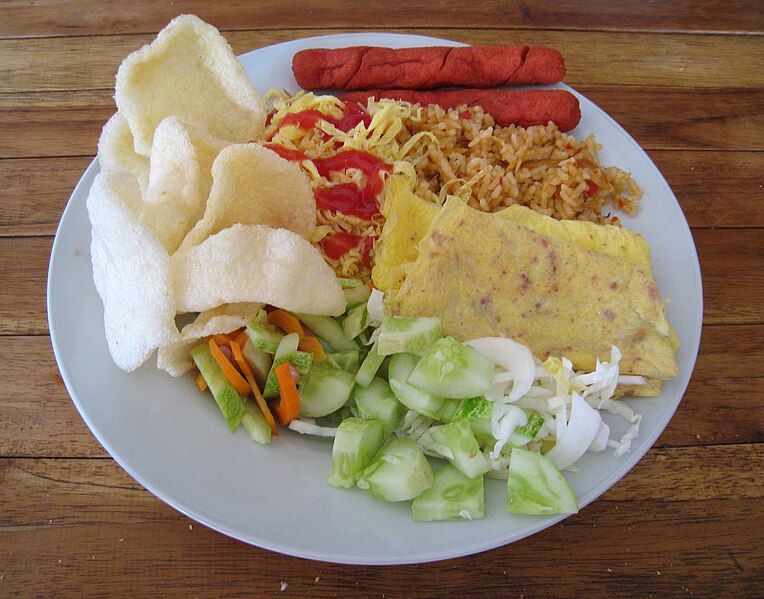FOOOOOOOOOOOOOOOD SPY!

1. Ayam pedis
The chef browns chicken thighs in a mixture of onions, candlenuts, gula jawa, tamarind, chicken stock—and ketchup. “I kind of cheated on that one,” Van Den Winkel says. To get a balance of spicy, sweet, and sour, he also uses lemongrass, sambal, and lime leaf.
2. Atjar campur
A pickled coleslaw, made with carrots, cabbage, onions, and lime leaf.
3. Sambal goreng buncis
These crunchy beans are accented with coconut milk, tamarind, and red chilies.
4. Kentang kering
Curried matchstick potato chips.
5. Nasi goreng
This dish doesn’t usually appear at a traditional rijsttafel: It’s made the next morning from whatever’s left over. But “everyone associates it with Indonesian food,” the chef says, so he makes his with carrots, onions, cabbage, and spices.
6. Sambal daging
Van Den Winkel cooks lean pork shoulder in a paste of ginger, galangal, onions, sambal, and trassi for nearly two hours, until it comes apart in shreds.
7. Bawang goreng
Garlicky fried shallots.
8. Sambal oelek
A spicy red-chili paste that’s massively popular in Indonesia, where there are over 300 varieties of the condiment.
9. Serungdeng
Crispy shaved coconut.
10. Rujak manis
A spicy and crunchy apple, pear, and cucumber chutney.
11. Sambal goreng acar ketimun
Pickled cucumbers.
12. Rendang Padang
Van Den Winkel’s version of this dish (typically served during special occasions) is native to the city of Padang and made from chunks of beef shoulder, stewed with coconut, cloves, spices, tamarind, and galangal.
13. Telor masak kecap
Eggs are cooked until nearly hard-boiled, then mixed with a paste of candlenuts, terasi, galangal, kecap manis, and tomatoes. Left for 12 hours, it develops a thin, flavourful crust.
14. Babi kecap
Rich chunks of pork belly are marinated in star anise, cardamom, onion powder, and sambal for two days, then slow-roasted. Before dinner, they’re fried and served with pickled bean sprouts. “They’ll pickle anything in Indonesia,” he says. “It creates that contrast you need with rich dishes like pork belly.”
15. Sate ikan asam manis bandeng
These swordfish skewers, a typical Indonesian street-vendor snack, are marinated in tamarind, kecap manis, sambal oelek, terasi, and galangal, then grilled and topped with raw scallions and fried shallots for texture.
16. Krupuk udang
Shrimp chips.
17. White rice
At a typical rijsttafel, everyone gets a cone of white rice for sopping up the different curries.
18. Kari Udang
This shrimp curry takes Van Den Winkel hours to make. “That’s a tricky dish, because you’ve got to stir the bumbu every five minutes, or else it’s gonna burn,” he says.
19. Sate ayam
These chicken skewers are marinated for two days in kecap manis, tamarind, lemon juice, and spices, then grilled and topped with a sweet peanut sauce.
20. Gado gado
“There are 1,001 varieties of gado gado,” says Van Den Winkel. “It’s basically just a salad.” His version features cucumbers, cabbage, bean sprouts, and green beans, served with a peanut sauce.
21. Rempeh
The spicy beef meatballs are made with oily ground candlenuts, rolled in coconut flakes, then fried and topped with a sweet coconut-milk sauce.
22. Sayur kembang kol
This cauliflower dish, made with green chilies, garlic, onions, coriander, and gula jawa, sits in a coconut broth accented with daun salam, an Indonesian bay leaf.
GLOSSARY
Kecap manis: Sweet soy sauce
Sambal oelek: Chili sauce
Terasi: Shrimp paste
Galangal: A plant similar to ginger
Gula djawa: A brown palm sugar
Bambu: A paste made of ground spices that serves as the base of most Indonesian curries
Katjang: A sweet, rich peanut sauce
Candlenut: Similar to a macadamia nut, and used to thicken sauces
 Quote
QuoteThey got it goreng onTurns out the Dutch love Indonesian cuisine almost as much as they do tulips and clogs. At Quince Bistro, an expat chef is whipping up a veritable feast of his favourite food.BY: Jacob Rutka
Toronto isn’t exactly hurting for multicultural restaurants, but we don’t have all our ethnic bases covered. Take the food of Indonesia: It’s as popular in the Netherlands as curry houses are in the U.K., but far less common on this side of the Atlantic.
A multi-course Indonesian feast is known as a rijsttafel (or rice table), and Michael Van Den Winkel, the Amsterdam expat and chef/owner at Quince Bistro, learned to cook them while performing his mandatory service in the Dutch navy. “Indonesian food is well integrated in Dutch culture,” he says. “But they don’t do the rijsttafel in Indonesia. It was the Dutch colonialists who had their Indonesian servants make 20 or 30 dishes and serve them all at once.”
For the past two years, Van Den Winkel and his wife, Jennifer Gittins, have offered quarterly rijsttafel dinners at their midtown restaurant. The menu might read like an unpronounceable grocery list, but it adds up to a colourful feast full of bold flavours drawn from Indonesia’s diverse ethnic groups. We break down all 22 dishes.
http://www.thegridto.com/life/food-d...-it-goreng-on/
 [/img]
[/img] [/img]
[/img] [/img]
[/img] [/img]
[/img]










 Quote
Quote